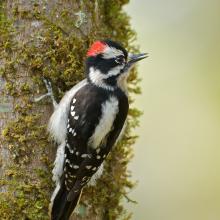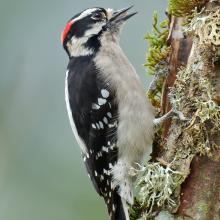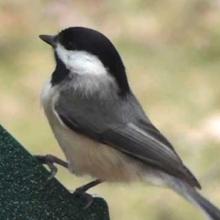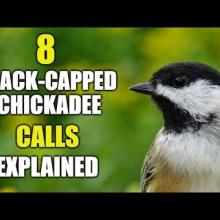

Join BirdNote tomorrow, November 30th!
Illustrator David Sibley and actor H. Jon Benjamin will face off in the bird illustration battle of the century during BirdNote's Year-end Celebration and Auction!
A family of dapper Black-capped Chickadees call as they hang upside down, pecking at alder seeds. A wren skulks and buzzes through the underbrush. A petite Downy Woodpecker whinnies nearby. Mixed-species flocks may include a dozen species and more than fifty individuals. More ears and eyes mean better detection of predators. Find your local Audubon chapter and learn more about birds, including this Black-capped Chickadee.
Support for BirdNote comes from the Cornell Lab’s Bird Academy, with online courses that share the wonder and joy of birds. More at AllAboutBirds.org.
BirdNote®
More Eyes and Ears —
Mixed-species Flocking Pays Off
Written by Bob Sundstrom
This is BirdNote!
[Red-breasted Nuthatch, Black-capped Chickadee, Ruby-crowned Kinglet, and a Downy Woodpecker introduced in text]
As you stand in the autumn woods, a Red-breasted Nuthatch calls while it hangs upside down on a pine cone, deftly removing the fat-rich seeds. Nearby, several Black-capped Chickadees inspect leaves and twigs for small insects or cocoons. A chattering Ruby-crowned Kinglet hovers at a branch tip. And a petite Downy Woodpecker whinnies. And they are all close at hand.
[Noisy flurry featuring Red-breasted Nuthatch]
This noisy flurry of small birds is a mixed-species flock, foraging and moving together in fall and winter. With the nesting season past, some small birds join forces. These loose associations can include a dozen species and more than fifty individuals. More watchful eyes mean better detection of predators, allowing each bird to spend more time feeding. And more individuals searching improve the odds that a rich feeding area will be found.
[Black-capped Chickadees again]
In much of North America, Black-capped Chickadees lead in forming such flocks, and – should a hawk be sighted – whistle an alarm call that the other species understand.
[Black-capped Chickadee alarm call]
If you’d like to learn more about the birds in your area, begin with a visit to our website, birdnote.org. I’m Mary McCann.
Support for BirdNote comes from the Cornell Lab’s Bird Academy, with online courses that share the wonder and joy of birds. More at AllAboutBirds.org.
###
Bird calls provided by The Macaulay Library of Natural Sounds at the Cornell Lab of Ornithology, Ithaca, New York. Black-capped Chickadee recorded by R.S. Little; Red-breasted Nuthatch by W.L. Hershberger; Downy Woodpecker by W.W.H. Gunn; Black-capped Chickadee mobbing call by R.C. Stein.
Producer: John Kessler
Executive Producer: Chris Peterson
© 2013 Tune In to Nature.org November 2018/2020 Narrator: Mary McCann
ID#110805mixedKPLU flock-01b-2009-11-11-MM








